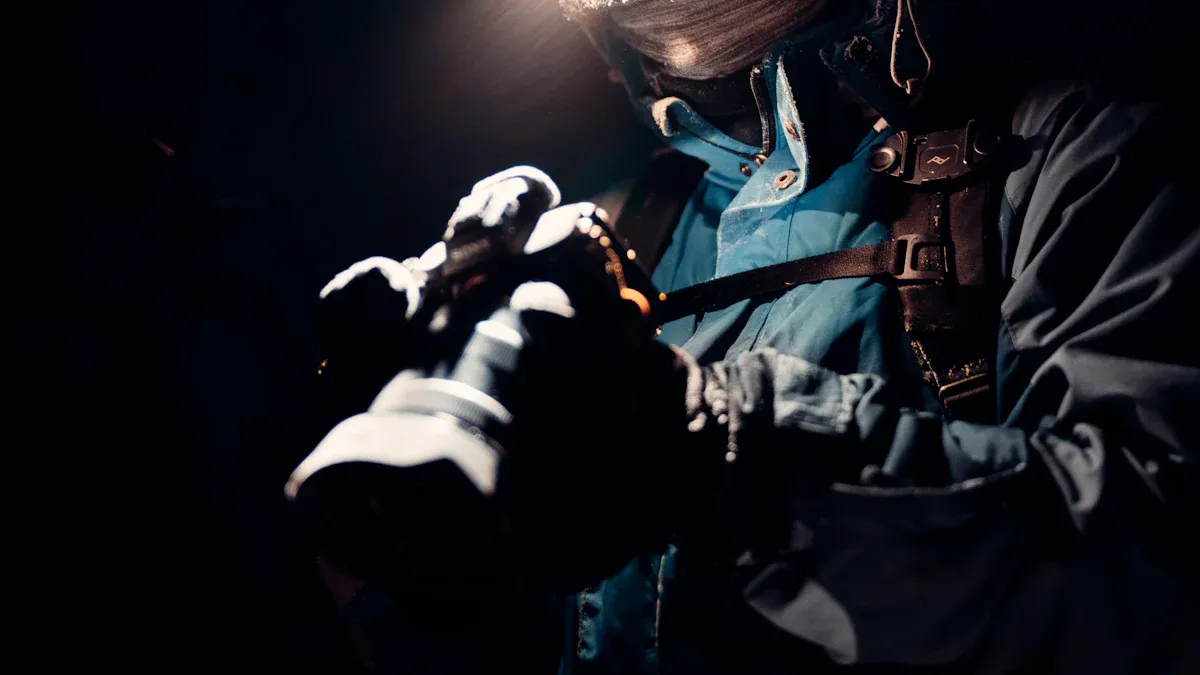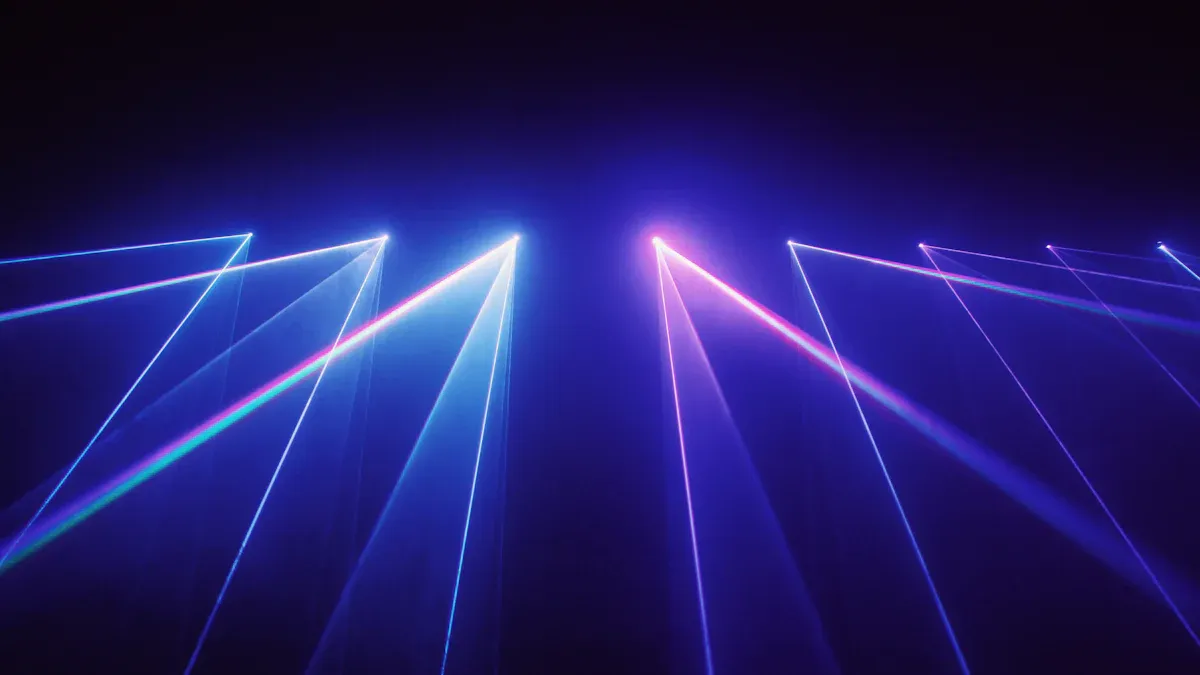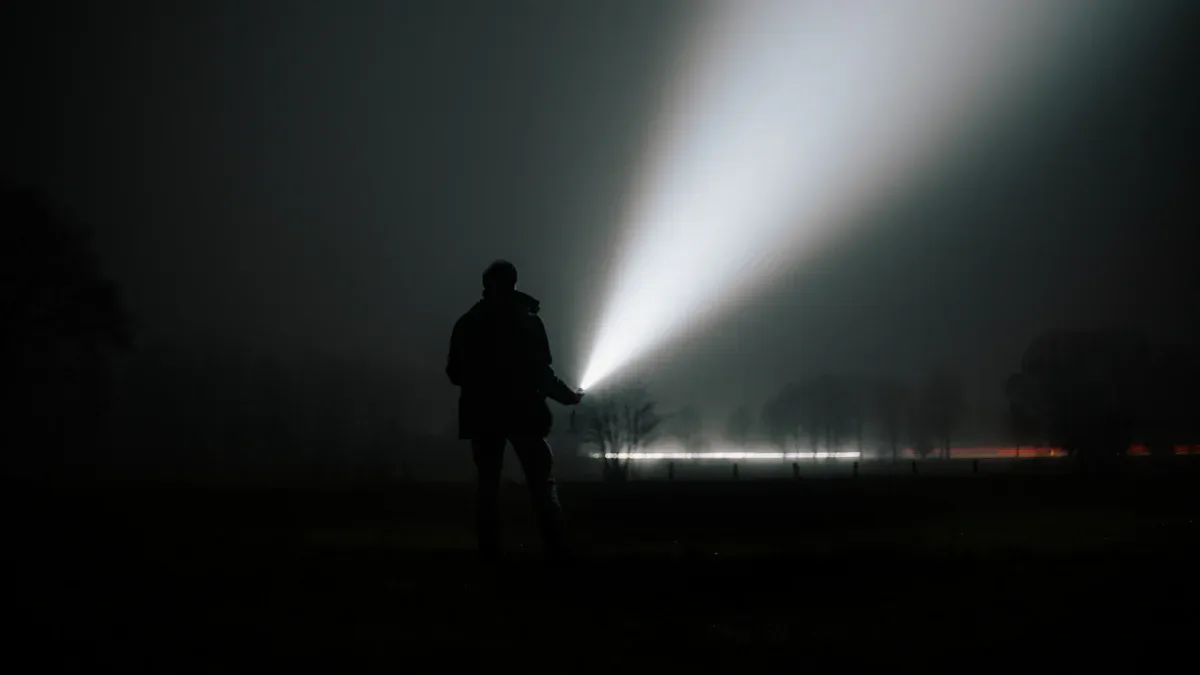Choosing the Right Flashlight Color Mix for Outdoor and Industrial Markets

Choosing the best flashlight is about more than brightness. You should think about color temperature, CRI, and brightness. These things help you see better and stay safe. A high CRI in your flashlight helps you see colors clearly. It also makes your eyes less tired. This is very important in places where color-coded items are used a lot.
CRI Value | Impact on Task Performance and Safety |
|---|---|
<60 | Bad color accuracy, more mistakes with color tasks |
80+ | Good for most jobs, easier on your eyes |
90+ | Very good color accuracy, important for safety with color codes |
A good led flashlight lets you change how bright it is. Custom flashlight production can help you get what you need. If you want a rechargeable flashlight or special features, pick what works best for your job and where you use it.
Key Takeaways
Pick a flashlight with a high CRI for better color accuracy. This lets you see colors well and helps your eyes feel less tired, especially when you do color-coded jobs.
Choose the right color temperature for where you are. Cool white is best outside. Warm tones are good in dusty places.
Think about the brightness level in lumens for your job. You need more lumens for detailed work. Fewer lumens are fine for simple tasks.
Find flashlights with waterproofing and durability for industrial use. These features help your flashlight last in hard conditions.
Custom flashlights can fit your special needs. You can pick the color mix and brightness that works for your job.
Color Options

White, Cool, and Warm Tones
When picking a flashlight, think about color temperature. This changes how well you see and how your eyes feel. There are three main choices: neutral white, cool white, and warm tones. Each one works best in different places.
Color Type | Color Temperature (K) | Description |
|---|---|---|
Neutral White | 3500K - 5000K | Looks natural and nice. It mixes warm and cool light. |
Cool White | 5000K - 6500K | Gives bright and clear light. Good for outdoor and work use. |
Cooler tones (5000K and up) help you see better. They also make your eyes less tired. Use them in work areas where safety is important.
Warmer tones (2700K – 3000K) feel cozy but do not show details well. These are better for relaxing than working.
Neutral tones (3500K – 4000K) help you feel comfy and stay focused. Use them in offices or places where you work a long time.
Red, Green, Blue, UV
You can choose flashlights with more than one color. Each color is good for different jobs outside or at work.
Color | Advantages |
|---|---|
Red | Keeps night vision, does not attract bugs, helps you stay hidden, good for hunting, and is used for emergencies. |
Green | Lets you see better in dim light, cuts through fog, does not scare animals, helps with hunting, and keeps night vision. |
Blue | Helps you see small details, finds glowing things, works well underwater, helps in medicine, and keeps you alert. |
UV | Checks real money and gems, finds hidden marks, and lights up glowing stuff at events. |
Red light helps you keep your night vision. It is good for looking at stars or in emergencies.
Green light helps you see in fog and does not bother animals. Use it for hiking or rescue work.
Blue light helps you see tiny things. It is good for water or medical jobs.
UV light helps you check for secret marks or find stains you cannot see.
High CRI and Neutral White
If you need to see colors well, pick a flashlight with high CRI and neutral white light. High CRI makes colors look real and bright, like sunlight. This helps you find mistakes and work faster.
Tip: If you work in factories or check things, high CRI light helps you spot problems fast and make fewer mistakes.
High CRI light shows colors the right way and helps you do your job better.
Neutral white light looks natural and helps you focus for a long time.
Use a led flashlight with high CRI for jobs where you need to check colors or sort things.
Flashlight Brightness & Lumens

How Many Lumens Needed
When picking a flashlight, think about how bright you need it to be. Lumens show how much light the flashlight gives off. The right amount of brightness helps you see well and stay safe. Some jobs need more light than others. For example, making gloves needs more light than watching a parking lot. Look at the table below to find the best brightness for your job.
Application Type | Recommended Lux Level |
|---|---|
Glove manufacturing | 1000-3000 lux |
Hat manufacturing | 500-3000 lux |
Jewelry and watch manufacturing | 2000-3000 lux |
Leather manufacturing | 200-750 lux |
Explosives manufacturing | 200-300 lux |
Paper manufacturing | 200-1500 lux |
Electrical equipment manufacturing | 500-750 lux |
Assembly work (Simple) | 200-300 lux |
Assembly work (Moderately difficult) | 500-750 lux |
Assembly work (Difficult) | 1000-1500 lux |
Assembly work (Very difficult) | 2000-3000 lux |
Assembly work (Extracting) | 5000-7500 lux |
Parking lots (general) | 1-60 lux |
Parking lots (security) | 12-10 lux |
Pick a flashlight with the right lumens for your space. If you work in a factory, you may want a led flashlight that is very bright. If you work outside at night, get one that lets you change how bright it is and lasts a long time.
Impact on Outdoor and Industrial Use
How bright your flashlight is can help keep you safe. It also helps you do your job better. Bright flashlights help you see dangers and move safely in dark places. You need to think about battery life too. More lumens use more battery, so plan for how long you will work.
Bright flashlights help you see clearly. You can spot problems and stay safe.
More lumens show more details, but use more battery. Check how long your flashlight will last.
If you use a very bright flashlight all the time, you may need to recharge or change batteries often.
Tip: Pick a flashlight that lets you change the brightness. This helps you save battery when you do not need it to be super bright and makes it last longer.
Always match your flashlight brightness to your job. For outdoor use, pick one that lights up your path enough. For work in factories, use a flashlight that is both bright and lasts a long time. This helps you stay safe and finish your work without stopping to recharge.
Choosing Factors
Task Requirements
You need to pick a flashlight that fits your job. Every job needs something different. Some jobs need you to use both hands, so hands-free flashlights help. Other jobs need a light that shines far or lasts a long time. The table below shows what to think about:
Factor | Description |
|---|---|
Match Certification | Use lights that are safe for dangerous places, like Zone 0 for flammable areas. |
Prioritize Lighting Needs | Pick lights that work best for your job, like spot lasers for seeing far away. |
Consider Mounting Options | Flashlights with magnets or helmet mounts let you work hands-free. |
Evaluate Runtime | Choose flashlights that last a long time, so you do not have to change batteries during important work. |
Choose for Durability | Pick flashlights made from strong materials and with high IP ratings for tough jobs. |
You should also look for tactical flashlights with special modes for emergencies. These features help you act fast and stay safe. If you want a rechargeable led flashlight, make sure it saves energy and money.
Environmental Conditions
Outdoor and factory places can be rough. You need flashlights that can handle water, dust, and drops. Waterproof and water resistance are important in wet places. Strong flashlights work better in hard jobs. Look for these things:
Waterproof and water resistance ratings (IPX7 or higher) for outside use.
Tactical flashlights with waterproof bodies for emergencies.
Water resistance for factories with spills or lots of moisture.
Waterproof switches and seals for flashlights that always work.
Water resistance for tactical flashlights used in rescue or security jobs.
Waterproof build for saving money and energy.
Water resistance for tactical flashlights in boats or rainy weather.
Waterproof flashlights for long-lasting use and strength.
Always check for water resistance and waterproof ratings before you buy. These things keep your flashlight safe and working in any weather.
Safety and Compliance
Safety rules keep you and your team safe. In dangerous places, you need intrinsically safe flashlights. These flashlights stop sparks or heat that could cause explosions. You must follow rules like ATEX and IECEx. The table below lists important certifications:
Certification | Description |
|---|---|
UL Certification | Checks if products are safe for people and meet the rules. |
IECEx Certification | Makes sure products are safe for dangerous places around the world. |
ATEX Certification | EU rules for tools used where explosions could happen. |
RoHS | Limits bad chemicals in electronics. |
CE Marking | Shows the product follows EU safety, health, and environment rules. |
You should also know the safety classes for tactical flashlights:
Class I Division 1: Safe for places with flammable gases or liquids.
Class I Division 2: Safe for places where these dangers are not common.
Class II Division 1: Safe for places with dangerous dust.
Class II Division 2: Safe for places where dust is not common.
Class III Division 1: Safe for places with fibers that can catch fire.
Class III Division 2: Safe for places where these fibers are not common.
Note: Always pick flashlight features that match your safety needs. This helps your flashlight work well and saves money in every situation.
Best Color Mixes
Outdoor Applications
You need the right flashlight color for outdoor fun. The right beam helps you see and keeps you safe. Different places need different flashlight colors. Cool white beams work best in open or wet places. These beams help you see through fog and rain. You can spot dangers and details quickly. If you hike, camp, or fish, use a cool white beam. It helps you see trails, water, and things in your way.
Warm tones are good for dusty or closed spaces. Warm beams stop glare from dust and sand. You can see shapes and edges without hurting your eyes. Warm beams help you read maps or check gear when caving or hiking in deserts. Neutral white beams are good for many places. Use them in forests, parks, or mixed areas. Neutral white beams give you comfort and let you see details. You can use one flashlight for many outdoor things.
Many outdoor activities need more than one color. Red beams keep your night vision safe. Use red beams for looking at stars, watching animals, or reading maps at night. Green beams help you see in fog or thick plants. Blue beams help you find fluids or follow trails. Some rechargeable flashlights let you switch between these colors. You always have the right light for every outdoor job.
Environment | Best Beam Color | Why It Works |
|---|---|---|
Open/Wet | Cool White | Cuts through fog and rain, shows details |
Dusty/Enclosed | Warm Tone | Reduces glare, helps with dust and sand |
Mixed/Forest | Neutral White | Versatile, balances comfort and detail |
Night Activities | Red/Green/Blue | Protects night vision, helps with tracking |
Tip: Pick rechargeable flashlights with beams you can change. You can pick the color and brightness for each outdoor activity. This saves battery and helps you see better.
Industrial Applications
Industrial jobs need special flashlights. You must see colors clearly and find problems fast. High CRI and Color-Rite beams help you do this. These beams show colors the way they really look. You can check wires, labels, and parts without mistakes. In factories or workshops, you need a flashlight with high CRI. You see every detail and avoid big errors.
Color rendering index (CRI) is a number that shows how well a light shows colors. A CRI of 100 means colors look perfect, like in sunlight. In jobs like medicine or art, seeing colors right is very important for making good choices.
Cool white beams are good for open or wet work areas. You can see spills, leaks, and dangers fast. Warm tones help in dusty or closed spaces. You avoid glare and see surfaces better. Neutral white beams are flexible for many jobs. Some rechargeable flashlights have all these beams in one. You can switch beams for each task.
Industrial jobs need strong flashlights. You want a tough flashlight for hard work. Rechargeable flashlights save money and make less trash. You need a beam that shines far and lights up your work area. Some rechargeable flashlights have magnets or clips. You can use both hands while working. You also need waterproof and tough flashlights. These features keep your flashlight working anywhere.
Industrial Setting | Best Beam Color | Key Features Needed |
|---|---|---|
Open/Wet Areas | Cool White | Long beam, waterproof, durable |
Dusty/Enclosed Spaces | Warm Tone | Anti-glare, dustproof, strong case |
Color-Critical Tasks | High CRI/Color-Rite | Accurate color, adjustable beam |
General Use | Neutral White | Versatile, rechargeable, hands-free |
Note: Rechargeable flashlights with high CRI beams help you see color-coded wires, labels, and safety signs. You make fewer mistakes and finish work faster.
Always pick flashlight features that fit your job. Choose rechargeable flashlights with the right color, brightness, and strength. You will work better and stay safe in every industrial place.
Color Mix Pros & Cons
White/Red
Flashlights with both white and red beams are common. This mix lets you use the flashlight in many ways. White light helps you see small things and work safely. Red light keeps your night vision safe and makes you harder to spot. You can use red light to read maps or send signals at night. Many people like this mix for camping, hunting, and emergencies.
Pros:
Keeps your night vision safe
Makes your eyes less tired in the dark
Good for signals and emergencies
Cons:
Red beam does not shine very far
Not good for jobs where you must see colors clearly
Tip: Pick a flashlight that lets you switch between white and red beams quickly. This helps you react fast when things change.
White/Green
A flashlight with white and green beams is good for foggy or wooded places. Green light helps you see shapes and movement in mist. Hunters and security teams use green beams because animals do not notice it much. White light helps you see clearly when you need to check or fix things.
Feature | White Beam | Green Beam |
|---|---|---|
Visibility | High | Good in fog or plants |
Stealth | Low | High |
Eye Comfort | Medium | High |
Pros:
Green beam helps you see better in bad weather
Helps you stay hidden from animals
Cons:
Green light can make some colors look strange
Not good for every inspection job
Multi-Color
Multi-color flashlights let you pick from white, red, green, and sometimes blue or UV. These flashlights work in many places and for many jobs. You get more choices in one tool, so you save space and money. Multi-color flashlights often use led technology, so the battery lasts longer and the flashlight is tough.
Pros:
Works for many different jobs
Helps with lots of tasks
Makes you safer with color signals
Cons:
More features can make the controls harder to use
Costs more than flashlights with only one color
Note: Multi-color flashlights give you the best mix of features and last a long time for hard jobs.
Selection Tips
Outdoor Checklist
When you get ready for outdoor fun, you need the right flashlight. The right flashlight keeps you safe and helps you be ready. Always bring a flashlight or headlamp, even if you think you will be home before dark. Use this checklist to help you remember what to bring:
Bring a flashlight or headlamp on every trip.
Check the battery before you leave home.
Pick a flashlight that lets you change how bright it is.
Choose one that can handle rain or wet weather.
Look for a flashlight that is small and light.
Pick one with different color modes for different jobs.
Make sure you can use it with gloves or cold hands.
Tip: A rechargeable flashlight helps you save money and makes less trash on long trips.
Industrial Checklist
Workplaces need strong and tough flashlights. You need a flashlight that works every day and in rough places. Use this checklist to help you pick the right one:
Pick a tough flashlight that does not break if dropped.
Make sure it is bright so you can see well.
Check that the battery lasts a long time.
Choose one that is waterproof for wet places.
Look for flashlights you can use hands-free, like with clips or magnets.
Pick a flashlight with safety labels for your job.
Make sure it has the right features for your work.
Decision Guide
You can pick the best flashlight by matching what you need with the right features. Use this easy guide:
Your Need | Best Choice |
|---|---|
Long outdoor trips | Lightweight, rechargeable, water-resistant flashlight |
Night work or emergencies | High brightness, multiple color modes, hands-free features |
Industrial tasks | Durable, waterproof, certified flashlight with long battery life |
Note: Always try your flashlight before you use it. Check every feature to make sure it works for your job and where you will use it.
Custom Flashlight Production
Tailored Color Mixes
Sometimes, store flashlights do not fit your needs. Custom flashlight production lets you pick the color mix you want. You can choose the color temperature, how bright it is, and the beam shape. This helps you see better and stay safe at work or outside.
Manufacturers can change the light’s strength, color temperature, and how it spreads. You can ask for high CRI if you need to see colors well. This is helpful in art galleries, stores, or when checking products. You also get to pick how bright the light is. Too much light can hurt your eyes, so a balanced light is best. Custom flashlight production lets you choose what is most important for your job.
Tip: You can ask for a rechargeable flashlight with special color mixes. This saves money and is better for the planet.
Industry-Specific Solutions
Each industry has its own lighting problems. Custom flashlight production helps by making flashlights for your job. You can ask for hands-free use, waterproof parts, or extra-strong flashlights. These choices help you work longer and safer.
Here are some ways manufacturers make flashlights better for different jobs:
Change light strength for safe and clear sight.
Set color temperature for the work area.
Use high CRI for checking colors.
Adjust brightness to stop eye strain.
Industry | Custom Feature Example |
|---|---|
Healthcare | High CRI, focused beam |
Security | Multiple color modes |
Construction | Rugged build, waterproof |
Outdoor Sports | Rechargeable, adjustable beam |
Custom flashlight production lets you control every part. You get a flashlight that fits your job, lasts longer, and keeps you safe.
Picking the right flashlight color mix, brightness, and CRI helps you stay safe and work better. High-CRI lighting lets you see colors clearly. You can finish your tasks faster. New LED technology gives you more color choices. It also keeps colors steady. Custom flashlights are strong and last a long time. They work well for hard jobs. Use checklists and guides to help you pick the best flashlight for your needs.
FAQ
What is the best flashlight color for outdoor use?
You should choose cool white for open or wet areas. This color helps you see details in fog or rain. Neutral white works well in forests or mixed environments. Red or green beams help protect your night vision during night activities.
Why does CRI matter in industrial flashlights?
High CRI lets you see colors accurately. You can spot color-coded wires, labels, and safety signs more easily. This reduces mistakes and improves safety in your workplace.
How do I know how many lumens I need?
Check your task and environment. For outdoor hiking, 200–500 lumens work well. For industrial work, you may need 500–2000 lumens. Always match the brightness to your job for best results.
Can I use one flashlight for both outdoor and industrial tasks?
You can use a multi-color, high-CRI flashlight with adjustable brightness. This type gives you flexibility for many jobs. Look for a durable, rechargeable model with several beam options.
See Also
A Complete Guide to Selecting Color Flashlights for Outdoors
Selecting the Ideal Color Flashlight for Hog Hunting
Tips for Selecting the Perfect Headlamp Flashlight
